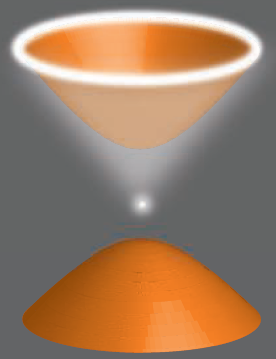Plasmon metamaterials promise powerful quantum information systems
November 1, 2011

"Hyperbolic” metamaterials can concentrate light into a narrow cone for more effective quantum information systems (credit: Zubin Jacob and Vladimir M. Shalaev/Science)
Merging plasmonics (electrons in silicon) and nanophotonics (light in fiber optics) combined with metamaterials.will lead to powerful new quantum computing systems, researchers at the University of Alberta and Purdue University’s Birck Nanotechnology Center propose.
Plasmons (coupling light to the free electrons of metals) have emerged as a way to effectively interface photonics (light) and nanoelectronics (chips) and could be used for high-speed switching and routing in future computers. Typically, plasmons are generated on a nanohole array or gold metal strip.
Plasmons have also been shown to preserve quantum information from the light used to generate them and can even exhibit entanglement. They can carry the quantum bit originally encoded in the photon — information survives the photon-to-plasmon-to-photon conversion and can be faithfully recovered.
What the Alberta and Purdue researchers have found is that plasmons created from “hyperbolic” metamaterials have a broad bandwidth and can channel the light into a narrow cone by transforming the space “perceived” by the light to be metallic in one direction and dielectric in another. This allows for infinitely many electromagnetic states and can lead to improved future quantum information systems, they suggest.
Ref.: Z. Jacob, V. M. Shalaev, Plasmonics Goes Quantum, Science, 2011 [DOI: 10.1126/science.1211736]